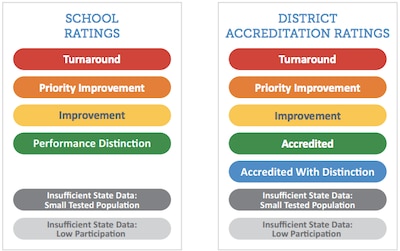Westminster Public Schools has improved enough to escape from the state’s crosshairs as a low-performing district, to the relief of school officials.
According to preliminary state ratings released Monday, the district has earned an “improvement” rating, or the middle rating on the state’s five-tier system for districts.
The district has been working under a state-ordered plan to raise student achievement and this year continued to post gradual but steady improvement in student growth across state test scores.

The district had just one more year to show that the plan was working, or else could have faced further state intervention. With the improvement this year, the district will no longer be under the state plan or timeline or face the threat of state action that could include closing schools or asking the district to merge with a higher-performing one.
But Westminster officials said their improvement plan will still be rolled out, because it was what the district intended to do anyway.
“Regardless, that’s Westminster’s plan,” Superintendent Pamela Swanson said Monday afternoon. “I believe we are going to continue to see progress. We have to double down to keep that up.”
When the district was facing state intervention for the first time, Westminster officials argued that the state’s rating system was unfair because of the district’s demographics and its education model.
For almost a decade, Westminster schools have been using a competency-based model where students aren’t placed in a class based on their age and corresponding grade level. Instead, students are grouped by their understanding of a certain subject, and can progress to another level as soon as they show that they’ve mastered that class content. The switch to the model caught national media attention when it was first announced. Despite its struggles, Westminster has steadfastly stood by its model, an innovation among public schools.
District officials say their improvement now is proof the model works.
“For many years we have asked the Colorado Department of Education to provide more flexibility in its accountability system to support innovation instead of focusing on high-stakes, once-a-year testing,” Swanson said in a press release. “The state resisted, but we pushed forward with our model and have now shown success, even by the traditional state standards. It’s very gratifying.”
One of the components of that plan was to work with education researcher Robert Marzano to create a school in the district to be used as a lab for teachers to develop their skills in using the competency-based model. The district closed the former Flynn Elementary School and reopened it this month as the Marzano School.
School-by-school ratings clearly show Westminster’s improvement.
This year only one school, Westminster High, fell into the bottom two tiers. The high school, however, did not start rolling out the district’s education model at the same time as the rest of the district, and when it did, did so one grade level at a time, district officials said.
Westminster had more schools in the top category than it had before — nine, more than twice as many as last year.
Besides its unique educational model, Westminster board President Ryan McCoy also credited increased student and parental engagement for the district’s improvement.
“Students have to own their work as well,” McCoy said.
But officials said that’s all part of getting better, or “going deeper” in using the competency-based model.

